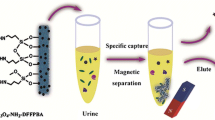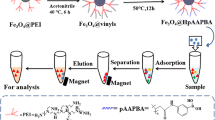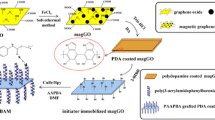Abstract
Boronate affinity materials have been widely used for selective capture of cis-diols such as nucleosides. Adsorbents with features of low binding pH and high adsorption capacity are highly desired. However, most reported materials only possess one of the two features. We have synthesized a 1,3,5-triazine-containing binary boronic acid by reacting cyanuric chloride with 3-aminophenylboronic acid, and the product was then grafted onto attapulgite (a fibrous aluminum-magnesium silicate). The resulting functionalized attapulgite exhibit low binding pH (5.0) and display high adsorption capacity (19.5 ± 1.1 mg⋅g−1 for adenosine). The material exhibits high selectivity for cis-diols even in the presence of a 1000-fold excess of interferences. It was applied to the selective extraction of nucleosides from human urine. Typical features of the method include (a) limits of detection in the range from 4 to 17 ng⋅mL−1, (b) limits of quantification between 13 and 57 ng⋅mL−1, (c) relative standard deviations of ≤9.1 %, and (d) recoveries of nucleosides from spiked human urine between 85.0 and 112.9 %. In our perception, the material and method offer a promising strategy for selective capture of cis-diols in the areas of proteomics, metabolomics and glycomics.

We have prepared 1,3,5-triazine-containing binary boronic acid-functionalized attapulgite. The material exhibited low binding pH (5.0) and high adsorption capacity (19.5 ± 1.1 mg⋅g‾1 for adenosine).





Similar content being viewed by others
References
Bjork GR, Ericson JU, Gustafsson CED, Hagervall TG, Jonsson YH, Wikstrom PM (1987) Transfer-RNA modification. Annu Rev Biochem 56:263–287
Fink K, Adams WS, Davis FW, Nakatani M (1963) The identification of 2-dimethylamino-6-hydroxypurine and its ribonucleoside in urine of normal and leukemic subjects. Cancer Res 23:1824–1829
Nakano K, Nakao T, Schram KH, Hammargren WM, Mcclure TD, Katz M, Petersen E (1993) Urinary-excretion of modified nucleosides as biological marker of RNA turnover in patients with cancer and AIDS. Clin Chim Acta 218:169–183
Seidel A, Seidel P, Manuwald O, Herbarth O (2015) Modified nucleosides as biomarkers for early cancer diagnose in exposed populations. Environ Toxicol 30:956–967
Chen R, Jiang XN, Sun DG, Han GH, Wang FJ, Ye ML, Wang LM, Zou HF (2009) Glycoproteomics analysis of human liver tissue by combination of multiple enzyme digestion and hydrazide chemistry. J Proteome Res 8:651–661
Liu YS, Yu J (2016) Oriented immobilization of proteins on solid supports for use in biosensors and biochips: a review. Microchim Acta 183:1–19
Mader HS, Wolfbeis OS (2008) Boronic acid based probes for microdetermination of saccharides and glycosylated biomolecules. Microchim Acta 162:1–34
Trupp S, Schweitzer A, Mohr GJ (2006) Fluororeactands for the detection of saccharides based on hemicyanine dyes with a boronic acid receptor. Microchim Acta 153:127–131
Fang CL, Xiong ZC, Qin HQ, Huang G, Liu J (2014) One-pot synthesis of magnetic colloidal nanocrystal clusters coated with chitosan for selective enrichment of glycopeptides. Anal Chim Acta 841:99–105
Bertok T, Katrlik J, Gemeiner P, Tkac J (2013) Electrochemical lectin based biosensors as a label-free tool in glycomics. Microchim Acta 180:1–13
Hasegawa U, Nishida T, van der Vilies AJ (2015) Dual stimuli-responsive phenylboronic acid-containing framboidal nanoparticles one-step aqueous dispersion polymerization. Macromolecules 48:4388–4393
Tan L, Chen KC, Huang C, Peng RF, Luo XY, Yang R, Cheng YF, Tang YW (2015) A fluorescent turn-on detection scheme for α-fetoprotein using Quantum dots placed in a boronate-modified molecularly imprinted polymer with high affinity for glycoproteins. Microchim Acta 182:2615–2622
Wang ST, Chen D, Ding J, Yuan BF, Feng YQ (2013) Borated titania, a new option for the selective enrichment of cis-diol biomolecules. Chem Eur J 19:606–611
Wang HQ, Feng W, Jia Q (2015) A graphene oxide functionalized with 3-aminophenylboronic acid for the selective enrichment of nucleosides, and their separation by capillary electrophoresis. Microchim Acta 182:185–192
He XM, Zhu GT, Zhu YY, Chen X, Zhang Z, Wang ST, Yuan BF, Feng YQ (2014) Facile preparation of biocompatible sulfhydryl cotton fiber-based sorbents by “thiol-ene” click chemistry for biological analysis. ACS Appl Mater Interfaces 6:17857–17864
Liu YC, Ren LB, Liu Z (2011) A unique boronic acid functionalized monolithic capillary for specific capture, separation and immobilization of cis-diol biomolecules. Chem Commun 47:5067–5069
Li HY, Liu YC, Liu J, Liu Z (2011) A wulff-type boronate for boronate affinity capture of cis-diol compounds at medium acidic pH condition. Chem Commun 47:8169–8171
Li HY, Wang HY, Liu YC, Liu Z (2012) A benzoboroxole-functionalized monolithic column for the selective enrichment and separation of cis-diol containing biomolecules. Chem Commun 48:4115–4117
Ren LB, Liu Z, Liu YC, Dou P, Chen HY (2009) Ring-opening polymerization with synergistic co-monomers: access to a boronate-functionalized polymeric monolith for the specific capture of cis-diol-containing biomolecules under neutral conditions. Angew Chem Int Ed 48:6704–6707
Wang W, He MF, Wang CZ, Wei YM (2015) Enhanced binding capacity of boronate affinity adsorbent via surface modification of silica by combination of atom transfer radical polymerization and chain-end functionalization for high-efficiency enrichment of cis-diol molecules. Anal Chim Acta 886:66–74
Li H, Shan YH, Qiao LZ, Dou A, Shi XZ, Xu GW (2013) Facile synthesis of boronate-decorated polyethyleneimine-grafted hybrid magnetic nanoparticles for the highly selective enrichment of modified nucleosides and ribosylated metabolites. Anal Chem 85:11585–11592
Zhu XY, Gu JL, Zhu JY, Li YS, Zhao LM, Shi JL (2015) Metal-organic frameworks with boronic acid suspended and their implication for cis-diol moieties binding. Adv Funct Mater 25:3847–3854
Chen T, Li HH, Ma Y, Liu XY, Zhang HX (2015) Synthesis of boronic-acid-functionalized magnetic attapulgite for selective enrichment of nucleosides. Anal Bioanal Chem 407:3525–3529
Kolmakov KA (2008) An efficient, “green” approach to aryl amination of cyanuric chloride using acetic acid as solvent. J Heterocycl Chem 45:533–539
Chen XM, Qin F, Liu YQ, Huang XD, Zou HF (2004) Synthesis of chiral stationary phases with radical polymerization reaction of cellulose phenylcarbamate derivatives and vinylized silica gel. J Chromatogr A 1034:109–116
Lubian E, Baldini F, Giannetti A, Trono C, Carofiglio T (2010) Solid-supported Zn(II) porphyrin tweezers as optical sensors for diamines. Chem Commun 46:3678–3680
Thongboonkerd V, Mungdee S, Chiangjong W (2009) Should urine pH be adjusted prior to gel-based proteome analysis? J Proteome Res 8:3206–3211
Dou P, Liang L, He JG, Liu Z, Chen HY (2009) Boronate functionalized magnetic nanoparticles and off-line hyphenation with capillary electrophoresis for specific extraction and analysis of biomolecules containing cis-diols. J Chromatogr A 1216:7558–7563
Li DJ, Li QJ, Wang SS, Ye J, Nie HY, Liu Z (2014) Pyridinylboronic acid-functionalized organic-silica hybrid monolithic capillary for the selective enrichment and separation of cis-diol-containing biomolecules at acidic pH. J Chromatogr A 1339:103–109
Du J, He MF, Wang XM, Fan H, Wei YM (2015) Facile preparation of boronic acid functionalized magnetic nanoparticles with a high capacity and their use in the enrichment of cis-diol-containing compounds from plasma. Biomed Chromatogr 29:312–320
Li DJ, Li Y, Li XL, Bie ZJ, Pan XH, Zhang Q, Liu Z (2015) A high boronate avidity monolithic capillary for the selective enrichment of trace glycoproteins. J Chromatogr A 1384:88–96
He HB, Sun YR, Li B, Yu QW, Wang TL, Feng YQ (2013) Boronate affinity solid-phase extraction based on functionalized magnesia-zirconia composite for enrichment of nucleosides in human urine. Anal Method 5:1435–1441
Wang CZ, Xu HH, Wei YM (2016) The preparation of high-capacity boronate affinity adsorbents by surface initiated reversible addition fragmentation chain transfer polymerization for the enrichment of ribonucleosides in serum. Anal Chim Acta 902:115–122
Chen ML, Wei SS, Yuan BF, Feng YQ (2012) Preparation of methacrylate-based monolith for capillary hydrophilic interaction chromatography and its application in determination of nucleosides in urine. J Chromatogr A 1228:183–192
Szymanska E, Markuszewski MJ, Bodzioch K, Kaliszan R (2007) Development and validation of urinary nucleosides and creatinine assay by capillary electrophoresis with solid phase extraction. J Pharmaceut Biomed 44:1118–1126
Acknowledgments
This work was financially supported by the National Natural Science Foundation of China (No. 21375052, 21575055 and J1103307).
Author information
Authors and Affiliations
Corresponding author
Ethics declarations
The author(s) declare that they have no competing interests.
Electronic supplementary material
ESM 1
(DOCX 767 kb)
Rights and permissions
About this article
Cite this article
Li, H., Zhu, S., Cheng, T. et al. Binary boronic acid-functionalized attapulgite with high adsorption capacity for selective capture of nucleosides at acidic pH values. Microchim Acta 183, 1779–1786 (2016). https://doi.org/10.1007/s00604-016-1808-5
Received:
Accepted:
Published:
Issue Date:
DOI: https://doi.org/10.1007/s00604-016-1808-5




